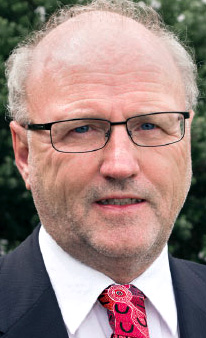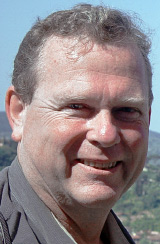

 A recent invitation to participate in a webinar to discuss ICANN's Role in Satellite Internet Governance as an enabler of UN Sustainable Development Goal (SDG) 9 prompted me to consider this issue. As a legal scholar with expertise in telecommunications infrastructure, I had much to say and discuss about the new mega-constellation phenomenon and its potential role in achieving SDG9, which, for me, is a multifaceted and fascinating subject. more
A recent invitation to participate in a webinar to discuss ICANN's Role in Satellite Internet Governance as an enabler of UN Sustainable Development Goal (SDG) 9 prompted me to consider this issue. As a legal scholar with expertise in telecommunications infrastructure, I had much to say and discuss about the new mega-constellation phenomenon and its potential role in achieving SDG9, which, for me, is a multifaceted and fascinating subject. more
 In an earlier post, I asked whether electronically steered antennas (ESAs) would replace parabolic antennas in satellite ground stations. I did some research and concluded that it is likely that they will. Next, I discussed the same question with ChatGPT and, while it made several false statements, it made a relevant point that I had overlooked. The relevant addition was positive, but the errors were troublesome, so I decided to try ChatGPT's competitor Google Bard. more
In an earlier post, I asked whether electronically steered antennas (ESAs) would replace parabolic antennas in satellite ground stations. I did some research and concluded that it is likely that they will. Next, I discussed the same question with ChatGPT and, while it made several false statements, it made a relevant point that I had overlooked. The relevant addition was positive, but the errors were troublesome, so I decided to try ChatGPT's competitor Google Bard. more
 Karl Bode recently wrote an excellent article highlighting the overhyping of wireless technologies. He's right, and for the last twenty years, we've been told that a world-changing wireless technology is coming soon, but none ever materialized. No wireless technology has been a bigger flop than 5G when comparing the hype to the eventual reality. The hype for 5G was amazingly over-the-top. more
Karl Bode recently wrote an excellent article highlighting the overhyping of wireless technologies. He's right, and for the last twenty years, we've been told that a world-changing wireless technology is coming soon, but none ever materialized. No wireless technology has been a bigger flop than 5G when comparing the hype to the eventual reality. The hype for 5G was amazingly over-the-top. more
 I am often asked by cities about the option of building a municipal fixed wireless broadband network. As a reminder, fixed wireless, in this case, is not a cellular system but is the point-to-multipoint technology used by wireless Internet service providers (WISPs). My response has been that it's possible but that the resulting network is probably not going to satisfy the performance goals most cities have in mind. more
I am often asked by cities about the option of building a municipal fixed wireless broadband network. As a reminder, fixed wireless, in this case, is not a cellular system but is the point-to-multipoint technology used by wireless Internet service providers (WISPs). My response has been that it's possible but that the resulting network is probably not going to satisfy the performance goals most cities have in mind. more
 The FCC voted recently to implement consumer broadband labels. This was required by section 60504 of the Infrastructure Investment and Jobs Act. The new rules will become effective after the Office of Management, and Budget approves the new rules and after the final notice is published in the federal register. ISPs will then generally have six months to implement the labels. The labels look a lot like the nutrition labels that accompany food. more
The FCC voted recently to implement consumer broadband labels. This was required by section 60504 of the Infrastructure Investment and Jobs Act. The new rules will become effective after the Office of Management, and Budget approves the new rules and after the final notice is published in the federal register. ISPs will then generally have six months to implement the labels. The labels look a lot like the nutrition labels that accompany food. more
 The first announcement came from OneWeb. The company successfully launched 36 new satellites with rockets supplied by NewSpace India Limited. This new rocket company was formed in 2019 and is a public-sector undertaking sponsored by the Indian Government and an arm of the India Space Research Organization. This launch is a reminder that many parts of the world are now interested in the space business. more
The first announcement came from OneWeb. The company successfully launched 36 new satellites with rockets supplied by NewSpace India Limited. This new rocket company was formed in 2019 and is a public-sector undertaking sponsored by the Indian Government and an arm of the India Space Research Organization. This launch is a reminder that many parts of the world are now interested in the space business. more
 "Saint Elon" is a bit much but ... It started with a tweet from Ukraine's Minister of Digital Transformation. The quoted text below is excerpts from How Elon Musk's Starlink satellite internet keeps Ukraine online in The Kyiv Independent. "Among the Ukrainian military, Elon Musk, the richest tech entrepreneur in the U.S., is often half-jokingly referred to as 'Saint Elon.'. The reason is Starlink, Musk's satellite communication system that keeps many Ukrainians, most importantly the military... more
"Saint Elon" is a bit much but ... It started with a tweet from Ukraine's Minister of Digital Transformation. The quoted text below is excerpts from How Elon Musk's Starlink satellite internet keeps Ukraine online in The Kyiv Independent. "Among the Ukrainian military, Elon Musk, the richest tech entrepreneur in the U.S., is often half-jokingly referred to as 'Saint Elon.'. The reason is Starlink, Musk's satellite communication system that keeps many Ukrainians, most importantly the military... more
 The NASA-sponsored Artemis program is the first step in the next era of human exploration. Together with a large number of international government and academic partners as well as businesses -- and based on international standards -- NASA will establish a sustainable presence on the Moon. more
The NASA-sponsored Artemis program is the first step in the next era of human exploration. Together with a large number of international government and academic partners as well as businesses -- and based on international standards -- NASA will establish a sustainable presence on the Moon. more
 We got a recent analysis of Starlink broadband speeds from Ookla, which gathers huge numbers of speed tests from across the country. The U.S. average download speeds on Starlink have improved over the last year, from an average of 65.72 Mbps in 1Q 2021 to 90.55 Mbps in 1Q 2022. But during that same timeframe, upload speeds got worse, dropping from an average of 16.29 Mbps in 1Q 2021 to 10.70 Mbps in 1Q 2022. more
We got a recent analysis of Starlink broadband speeds from Ookla, which gathers huge numbers of speed tests from across the country. The U.S. average download speeds on Starlink have improved over the last year, from an average of 65.72 Mbps in 1Q 2021 to 90.55 Mbps in 1Q 2022. But during that same timeframe, upload speeds got worse, dropping from an average of 16.29 Mbps in 1Q 2021 to 10.70 Mbps in 1Q 2022. more
 There was a naive idealism in the early days of the Internet that attempted to rise above the tawdry game of politics. Somehow, we thought that we had managed to transcend a whole set of rather messy geopolitical considerations that plagued the telephone world and this new digital space that the Internet was creating was simply not going to play by the old rules. more
There was a naive idealism in the early days of the Internet that attempted to rise above the tawdry game of politics. Somehow, we thought that we had managed to transcend a whole set of rather messy geopolitical considerations that plagued the telephone world and this new digital space that the Internet was creating was simply not going to play by the old rules. more
 The Arctic region has largely been left out of the broadband arena in the past due to the high cost of building last-mile broadband infrastructure. The primary broadband available in the region has been provided for decades by Iridium Communications, which provided only low-bandwidth connections capable of supporting satellite phones and low-bandwidth monitoring devices. more
The Arctic region has largely been left out of the broadband arena in the past due to the high cost of building last-mile broadband infrastructure. The primary broadband available in the region has been provided for decades by Iridium Communications, which provided only low-bandwidth connections capable of supporting satellite phones and low-bandwidth monitoring devices. more
 There was a recent article in FierceTelecom that quotes a leading cable company consultant as saying that cable companies are not likely to universally upgrade broadband networks in the future. The consultant is Sean McDevitt, a partner at Arthur D. Little, a consulting firm that largely works for the giant ISPs. In the past, when a cable company migrated from DOCSIS 1.0 to 2.0 and to 3.0, everybody in a community was upgraded to the latest technology. more
There was a recent article in FierceTelecom that quotes a leading cable company consultant as saying that cable companies are not likely to universally upgrade broadband networks in the future. The consultant is Sean McDevitt, a partner at Arthur D. Little, a consulting firm that largely works for the giant ISPs. In the past, when a cable company migrated from DOCSIS 1.0 to 2.0 and to 3.0, everybody in a community was upgraded to the latest technology. more
 Russians have targeted Ukrainian electricity and communication infrastructure. In some areas, there may not be any utility poles left standing, and underground conduits may have been bombed to oblivion. Starlink has been an important tool for these brave people to coordinate their resistance to Putin's brutal invasion. Satellite communication doesn't require any middle-mile infrastructure. more
Russians have targeted Ukrainian electricity and communication infrastructure. In some areas, there may not be any utility poles left standing, and underground conduits may have been bombed to oblivion. Starlink has been an important tool for these brave people to coordinate their resistance to Putin's brutal invasion. Satellite communication doesn't require any middle-mile infrastructure. more
 Our broadband policies always seem to lag the market. If and when the FCC seats the fifth Commissioner, it's expected that the agency will raise the definition of broadband from 25/3 Mbps to 100/20 Mbps. That change will have big repercussions in the market because it will mean that anybody that can't buy broadband speeds of at least 100/20 Mbps would not have broadband. That's how an official broadband definition works -- you either have broadband, or you don't. more
Our broadband policies always seem to lag the market. If and when the FCC seats the fifth Commissioner, it's expected that the agency will raise the definition of broadband from 25/3 Mbps to 100/20 Mbps. That change will have big repercussions in the market because it will mean that anybody that can't buy broadband speeds of at least 100/20 Mbps would not have broadband. That's how an official broadband definition works -- you either have broadband, or you don't. more
 On March 2, Russia covered the US flag on the Roscosmos Space Agency rocket that was scheduled to launch 36 OneWeb broadband satellites on March 5. The Russians made two obviously untenable demands -- that OneWeb guarantee that the satellites would not be used for military purposes and the United Kingdom government remove its investment in the company. OneWeb declined, and the satellites were removed from the rocket. more
On March 2, Russia covered the US flag on the Roscosmos Space Agency rocket that was scheduled to launch 36 OneWeb broadband satellites on March 5. The Russians made two obviously untenable demands -- that OneWeb guarantee that the satellites would not be used for military purposes and the United Kingdom government remove its investment in the company. OneWeb declined, and the satellites were removed from the rocket. more